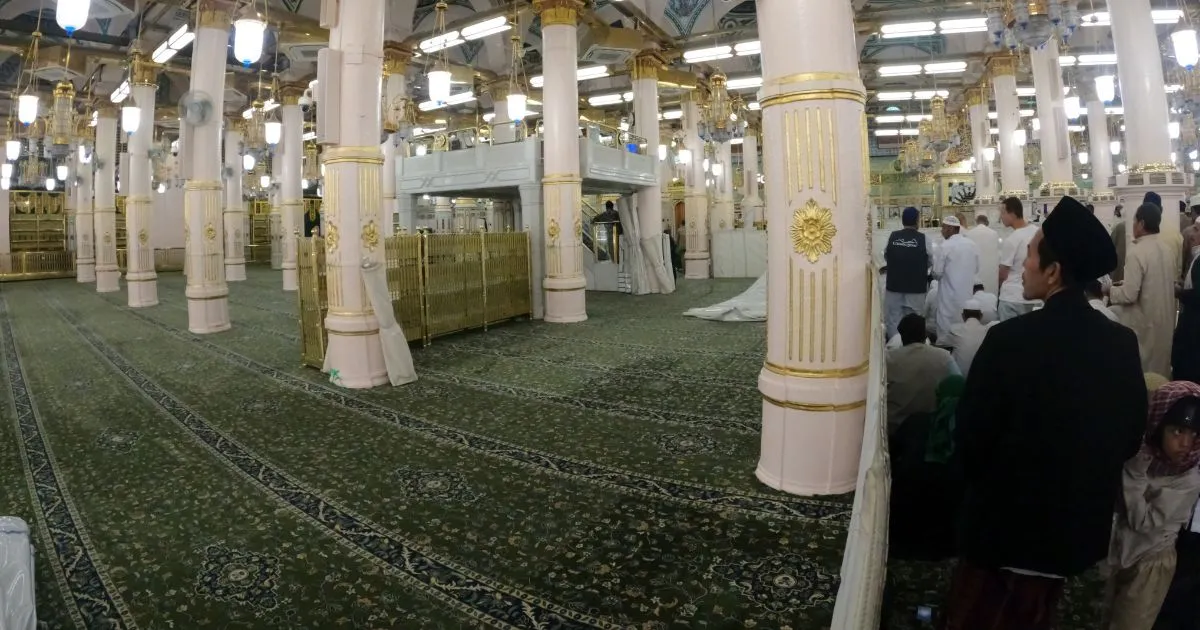Authentic Etiquette for Visiting the Prophet’s (ﷺ) Grave
Table of Contents
Authentic Etiquette for Visiting the Prophet’s (ﷺ) Grave
(Based on Quran, Sahih Hadith, and Understanding of the Salaf)
1. Entering Masjid an-Nabawi
- Enter with the right foot, saying:
“بِسْمِ اللهِ، وَالصَّلَاةُ وَالسَّلَامُ عَلَى رَسُولِ اللهِ، اللَّهُمَّ افْتَحْ لِي أَبْوَابَ رَحْمَتِكَ”
(“In the name of Allah, and blessings and peace be upon the Messenger of Allah. O Allah, open for me the doors of Your mercy.”) - This follows the general Sunnah for entering any mosque (Bukhari, Muslim).
2. Praying in the Mosque First
- Perform Tahiyyat al-Masjid (2 rak’ahs) before anything else, as the Prophet (ﷺ) said:
“If one of you enters the mosque, let him not sit until he prays two rak’ahs.” (Bukhari, Muslim) - The Rawdah (area between the Prophet’s (ﷺ) house and minbar) is a blessed place to pray, as he (ﷺ) said:
“What is between my house and my pulpit is a garden from the gardens of Paradise.” (Bukhari) - No authentic evidence specifies praying near the minbar’s pillar—this is not from the Sunnah.
3. Visiting the Grave: Correct Procedure
- Stand facing the qibla, with the grave to your side or front, not facing the grave directly (to avoid resemblance of worshiping it).
- Send salam ONLY to the Prophet (ﷺ), saying:
“السَّلَامُ عَلَيْكَ يَا رَسُولَ اللهِ”
(“Peace be upon you, O Messenger of Allah.”) - Do NOT add excessive phrases like “يا شفيع المذنبين” (O intercessor of sinners), as this resembles supplicating to other than Allah.
4. Greeting Abu Bakr and Umar (رضي الله عنهما)
- After greeting the Prophet (ﷺ), you may greet Abu Bakr and Umar (رضي الله عنهما) briefly:
“السَّلَامُ عَلَيْكَ يَا أَبَا بَكْرٍ، السَّلَامُ عَلَيْكَ يَا عُمَرُ”
(“Peace be upon you, O Abu Bakr; peace be upon you, O Umar.”) - No evidence supports lengthy praises or moving in a specific pattern around the graves.
5. The Prophet (ﷺ) Hears Your Salam
- The Prophet (ﷺ) said:
“There is no one who sends salam upon me except that Allah returns my soul to me so I may return his greeting.” (Abu Dawud, authenticated by Al-Albani) - Do NOT believe he is alive in his grave in a worldly sense—this is the Aqeedah of Ahlus-Sunnah.
6. Making Du’a After Salam
- Turn to face the qibla and make du’a to Allah alone, asking for:
- Forgiveness
- Acceptance of the Prophet’s (ﷺ) intercession for you
- Guidance to follow his Sunnah
- Avoid:
- Making du’a to the Prophet (ﷺ) (this is shirk)
- Rubbing hands on the grave or walls (bid’ah)
- Circling the grave (like tawaf)
7. Leaving the Mosque
- Exit with the left foot, saying:
“بِسْمِ اللهِ، وَالصَّلَاةُ وَالسَّلَامُ عَلَى رَسُولِ اللهِ، اللَّهُمَّ إِنِّي أَسْأَلُكَ مِنْ فَضْلِكَ”
(“In the name of Allah, and blessings and peace be upon the Messenger of Allah. O Allah, I ask You for Your bounty.”)
Important Clarifications from the Scholars
- Ibn Taymiyyah (رحمه الله) said:
“Visiting the Prophet’s grave is a righteous deed, but it is not an obligation or a condition for the acceptance of Hajj.” (Majmu’ al-Fatawa) - Imam Malik (رحمه الله) was asked if one should face the grave while making du’a, and he replied:
“Face the qibla and make du’a, do not face the grave.” (Al-Qadi ‘Iyad, Ash-Shifa) - Sheikh Ibn Baz (رحمه الله) warned against:
- Kissing the grave or touching it for blessing (no basis in Sunnah).
- Traveling only to visit the grave (the Prophet (ﷺ) forbade traveling to mosques except for the three: Masjid al-Haram, Masjid an-Nabawi, and Masjid al-Aqsa).
Final Advice
- Follow the Sunnah strictly and avoid innovations.
- Do not exaggerate in praising the Prophet (ﷺ) beyond what is legislated.
- The best way to honor him (ﷺ) is to follow his teachings.
May Allah guide us to the straight path and allow us to visit His Messenger’s grave with sincerity and correctness. Ameen.

